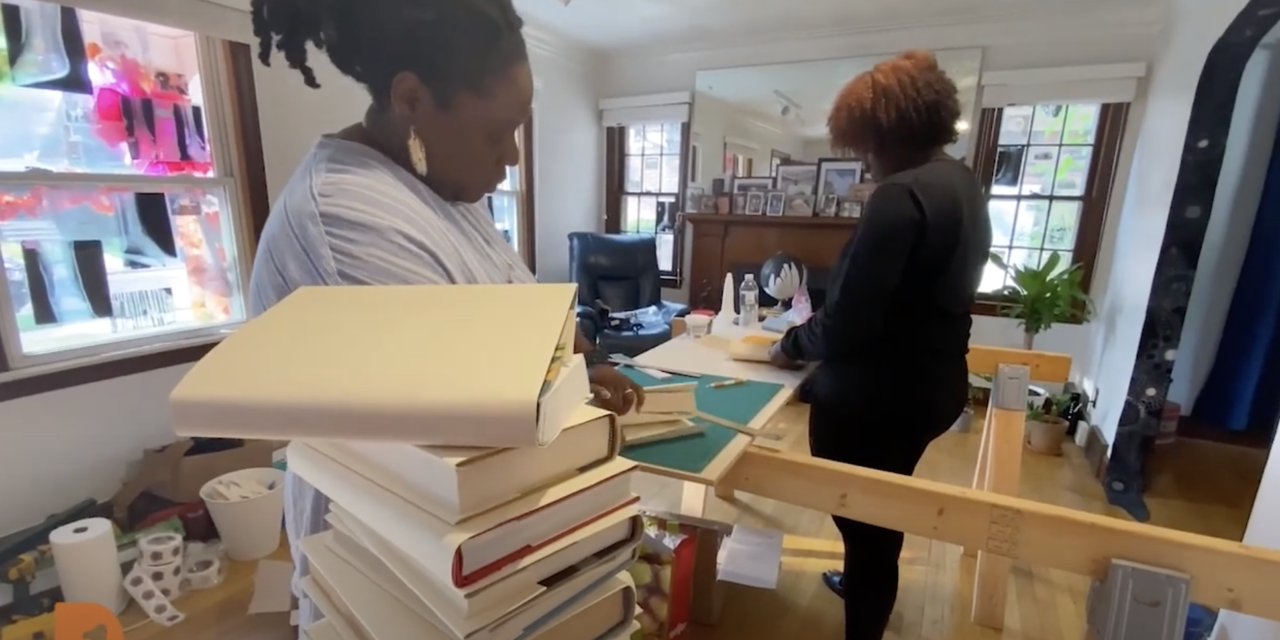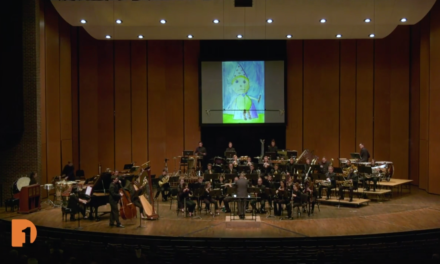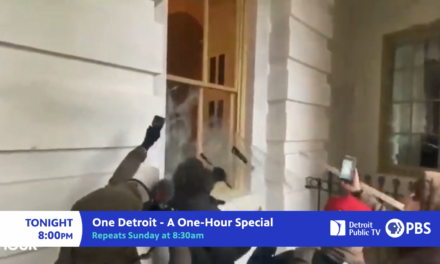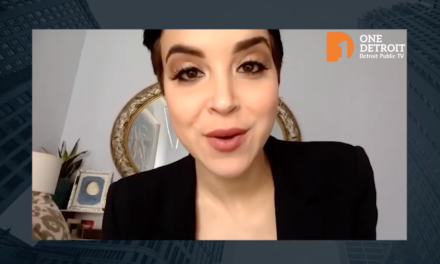Artist Asia Hamilton moved out of her childhood home in Detroit and along with Laurie Earle transformed it into a whole house interactive art exhibition called “WomxnHouse Detroit: The Art of Being Female in America Today”. Christy McDonald speaks to Asia about the exhibit that features 15 female artists who created art out of places and spaces in and around the home.
Full transcript:
Christy McDonald, Anchor / Managing Editor, One Detroit:
When you talk about being able to put that kind of art out and the power of a still photograph, how would you describe what still photography does in terms of capturing moments? Emotions, sometimes our most arresting things, come from a still photograph and not that moving video that we see every day.
Asia Hamilton, Co-curator, Womxnhouse Detroit:
I mean, it is a moment in time. It is a document of history. I mean, you know, a lot of people think that, you know, like oh, there, it’s a candid shot or, you know, let’s take a selfie. But that is the art history that you’re documenting. That is your legacy in your life. So, you know, photography, still photography is, you know, is so-such a, like a catalog of, you know, of these various different moments in our life. You know, video is beautiful, too, you know, it’s just the motion of that. But like something about a photograph really captures the essence of a person in that moment. You might not catch it in a video because it’s moving and you might-you might have missed it, but a photograph will be able to-to capture it and display it, as is.
Christy McDonald:
I love how you’re telling a story though, when you’re curating installations and exhibits because there is a special art to being able to gather all of the-all of the different pieces that make them tell a story throughout with the different artists. What is that thought process for you when you do an exhibit?
Asia Hamilton:
First of all, a lot of my exhibitions that are based on my own personal life experiences, I speak to like, life in a way that, you know, that has moved me or, you know, that is relatable to other people.
Christy McDonald:
Let’s talk about Womxnhouse and the exhibition that you have-installation that is actually happening in your childhood home. It’s 14 artists that you have gathered in this house, and it really is looking back at that famous exhibition from 1972 of-of the same name. Talk to me about how Womxnhouse here in Detroit came to be.
Asia Hamilton:
So Laura Earle, she is my-she is the chief curator for Womxnhouse. She actually did an exhibition in, I think it’s Manchester, Michigan, called “Dear Woman House,” and she turned her home into an exhibition space based on the model of Judy Chicago’s “Womanhouse.” So I had already decided that I wanted to turn my house into an artist residency for women. And, you know, I was actually getting prepared for that, doing a lot of, you know, renovation on the house and such. But, you know, she suggested that we have this exhibit. So we went down the line of thinking of different artists that would be great for this exhibit. And we thought of women who speaks to the female experience. You know, women who really talk about their experiences in their lives as women as well as, you know, sharing opportunities with-with other women artists. Fourteen awesome, diverse women from around Detroit or metropolitan Detroit area. And once we-once we got the women together, we did a series of conscious raising, you know, workshops where we spoke about our experiences as women in, you know, not just in the arts, but just period, you know, and how that relates to, you know, society today and back then.
Christy McDonald:
Yeah, I was just going to say, I mean, we look at the 70’s and the period in time for women and coming through, coming into our own and finding where are we in 2021? What have some of the reactions been of seeing Womxnhouse now?
Asia Hamilton:
We’ve had some very strong reactions. You know, we have one-one installation called “The Womb,” which is an actual like, walking into the womb of a woman. That’s done by Jessica DeMuro. And a lot of people have, you know, been touched by that. You know, just thinking about, you know, what women go through as far as childbirth or, you know, dealing with, you know, maybe the loss of a child, because that was what sprung from Jessica’s piece. Also, we had Sabrina Nelson. She did a piece in the bathroom, “Apothecary,” you know, just really speaks to healing and women and self-love and loving yourself and taking care of yourself naturally, you know, and not, you know, putting society’s, you know, chemicals all over yourself to make yourself more beautiful. Another piece speaks to abortion and you know our right to choose. And you know how-you know the bill that was passed in Texas has taken away that right for women. So, you know, there is various different things that have-has pulled the heartstrings of people who have come into this space. And then there’s some funny pieces. You know, I, you know, I did some art. I was in it too. Yeah, there-my piece is on the front porch, it’s called “Fall in Love.” On the porch, it’s a porch swing, and it’s covered in fall stuff and it smells good. And it’s all about the lovey dovey feelings of love. But it’s also a fairy tale. You know, the fairy tale that we are, you know that we’re taught growing up as a kid about what you know, what love is and what it holds. And then in the back on the back porch, there’s a picture of a man and woman pointing fingers at each other. So every part of the house has become a part of the art.
Christy McDonald:
And for it to be your childhood home, your journey, becoming an artist and then giving your childhood space to other women to express their art. There’s something really powerful about that Asia.
Asia Hamilton:
I-the house has always been a house full of women. You know, there are more women in my family than there are men. Having the house be a space for art is-is my give back to that community. To be able to share with them how I see art and how I’ve experienced it and let them see it and experience it, it is like my pleasure. It’s my pleasure seeing my neighbors drive by and slow down and say, “what’s going on here?” You know, I’m like, “come on in!” And when they come in and they experience the art, I’m like, that is what that’s-that’s what this is all about.
Christy McDonald:
So Asia, what’s next? What’s next for you after-after Womxnhouse?
Asia Hamilton:
Well, Womxnhouse, you know, in January, we’ll be selecting six-six artists. Well, three artists, then three curators to live in the house and they will be, you know, pushing on with the next, the next chapter of Womxnhouse. So I believe and I want that to kinda continue on that legacy, to continue on in that space. Become like a staple in the-in that neighborhood as an art space for not just for women artists coming, you know, emerging women artists, but as well for, you know, for the community. So, but after Womxnhouse, we are focusing on a community garden called Detroit Infinity Gardens. And earlier this year we did an exhibit called “Flower Therapy,” which was dedicated to my mom, who had passed from COVID, when to have somebody very close, me and my mom were real close. So, you know, catch it and then me catch it too was like, oh, this is very real and people who making a joke about it, they need to really get it together. But myself and my friend Kayana, she lost her father, and so did several of my friends, lost their, you know, immediate family members to COVID. And I felt like it was a time that we needed a space for healing.
Christy McDonald:
Yeah.
Asia Hamilton:
I needed to be healed, like I needed that space for healing. And so I did an exhibit called “Flower Therapy,” which was all live floral art installations, and the gallery smelled so great. And we raised money to put into a community garden, which will be a make-up of various different types of gardens, like a herb garden or a memorial park or, you know, you know, trees or whatever, you know. So we have some ideas and play, and I’m excited about working on that project. Get my hands dirty, literally.





